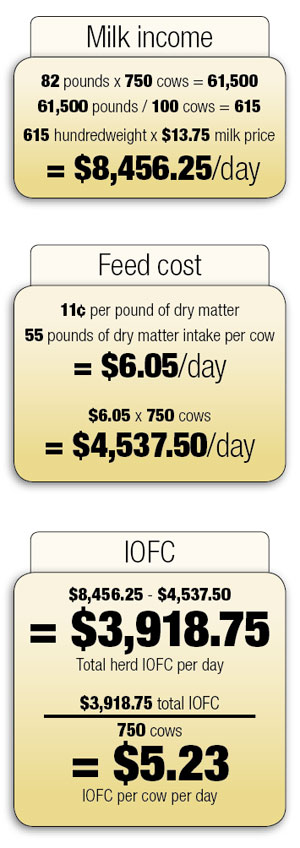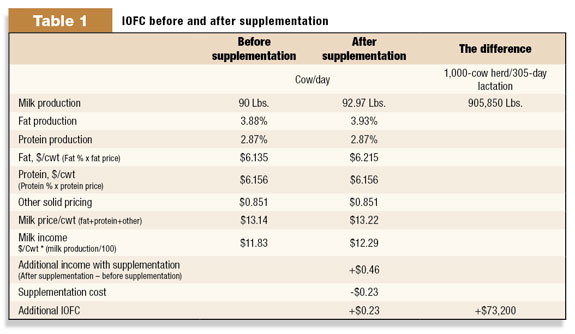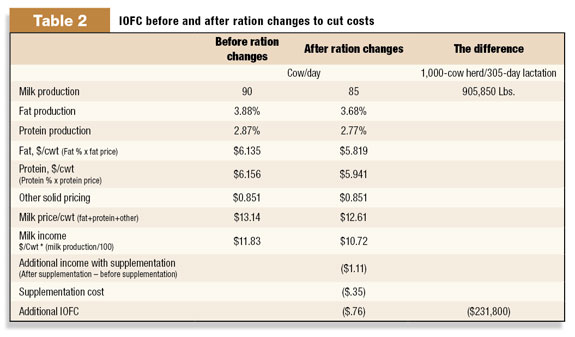Producers feeding high-quality ingredients to their herds are often faced with the question, “Is this making my dairy more money or just increasing my ration costs?” While it’s hard to know the exact impact specific ingredients may have on herd performance, one financial metric can help answer this question with more accuracy. Income over feed cost (IOFC) is a proven financial measurement to economically evaluate if feed ingredients are generating additional income for the dairy operation.

Defining IOFC
As its name implies, IOFC gauges how much additional income can be generated over the cost of feed. As the largest expense for your dairy operation, having a grasp of your feed costs allows you to make business-minded decisions on which ingredients are having a profitable impact. Knowing how to calculate IOFC can also help you identify the performance improvements needed to make an initial investment profitable.
IOFC is calculated by subtracting feed costs from milk production income. The following equation further explains the calculation:
Milk income per day - feed costs = Total herd IOFC per day
Total IOFC/number of milking cows = IOFC per cow per day
The calculation may be simple, but it relies on the accuracy of the information supplied to generate usable information. Below is an example calculation to show how it can effectively be utilized on your dairy:
Number of lactating cows: 750
Production per cow: 82 pounds
Milk Price: $13.75
Feed cost: $0.11/pound of dry matter
As this example shows, the herd’s performance generates an additional $5.23 per cow more than the cost of feed for the dairy operation. As the amount of IOFC increases, more money can be used for other daily operation expenses beyond diet formulation.
Applying IOFC to your dairy
IOFC allows you to identify the amount of income potential before a feeding or ingredient change is made. With the current low milk prices and the tough markets over the past 18 months, one of your first inclinations may be to cut feed costs to save money in the short term. However, when you remove high-quality feed ingredients that deliver nutrients to help your herd meet their production potential, you may lose milk production and generate less income.
To better illustrate how IOFC can be applied to your dairy, below are two scenarios for how the calculation can help a dairy operation make informed feed purchasing decisions.
Scenario #1: Potential for more income
A dairy operation is considering adding a new ingredient to their ration that is backed by extensive on-farm and university research. The feed ingredient is to be fed in the fresh and high-producing pens and is proven to increase milk and component production levels.

Table 1 compares the herd performance prior to supplementation with the improvements seen in performance when the supplement was fed.
As the example shows, the feed ingredient generated an additional $0.23 IOFC per cow per day for the dairy operation. While it did cost more upfront to include in the ration, the financial benefits through improved milk and component production results in additional income for the dairy.
Scenario #2: Potential for lost income
A dairy operation is looking to cut ration costs in an effort to reduce input costs. The dairy removed a proven feed ingredient that had been included to deliver the high-quality nutrients needed to reach peak milking string potential.

Table 2 outlines lost income potential based on reduced milk and component production.
While the ration costs were reduced by $0.35 per cow per day, there was a loss of $0.76 per cow per day in income due to the reduced milk and component production. It actually would have generated more IOFC for the dairy if they would have continued to feed the supplement before they tried to cut ration costs.
Tips and tricks of IOFC
To ensure the IOFC calculation is being utilized to its fullest advantage as you make feed and supplement purchasing decisions, the following advice can help advance your decision-making process using the IOFC equation:
- Calculate for certain groups. Since some feed ingredients will be fed to only certain groups of cows – like high-producing or close-up cows – IOFC should take into consideration the cows that will be receiving the feed ingredient. This gives a more accurate picture of when and how additional income is generated by removing animals not influenced by the ration change.
- Recalculate frequently. IOFC will change as feed costs and milk prices change. By calculating this number on a regular basis, you can continually evaluate and compare your IOFC. Since both milk production and feed intake are routinely calculated on the dairy, it should be easy to recalculate on a regular basis.
- Evaluate herd and per-cow numbers. IOFC can be evaluated for individual animals, the whole herd and certain groups of cows. Evaluate IOFC across all groups of milking animals and as individual animals to see where the potential lies for greater IOFC generation. You might find that certain groups of cows have the potential to generate additional IOFC, which can help guide your business decisions.
- There’s more to IOFC than milk and feed. While milk price and feed costs are often the first two numbers considered when calculating IOFC, other performance factors – like reproductive function, immune response and incidence of metabolic disorders – will directly impact IOFC for the dairy operation. Take into consideration any health responses seen with ration changes, as they can make a big impact on herd performance.
As you look to identify the “musts” of your ration, help redefine how you view feeds and ingredients based on the quality they bring to the diet. Removing feeds that help your herd reach their full potential may actually cost you more than you save; IOFC can help make this distinction and steer your financial decision-making for additional on-farm profits. PD

-
Elliot Block
- Senior Manager of Technology
- Arm & Hammer Animal Nutrition
- Email Elliot Block





